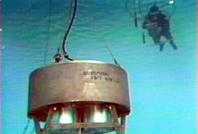|
EUROPEAN CETACEAN BYCATCH CAMPAIGN |
|
U.S. Navy Sonar System Blocked by Federal Court |
|
|
|
SURTASS LFA undergoing tests |
|
Scheduled for immediate deployment, the sonar system, known as Surveillance Towed Array Sensor System Low Frequency Active sonar (SURTASS LFA), relies on very loud, low frequency sound to detect submarines at great distances. |
|
National Marine Fisheries officials respond to a pilot whale stranding. |
|
"Deployment of LFA over 75 percent of the world's oceans, more than 14 million square miles in the first year alone, threatens marine life on a staggering and unprecedented geographic scale, not just the 'small number of marine mammals' that the law allows, but countless marine mammals around the world," Reynolds said. |
|
"The frightening thing about LFA is that we're flying blind, because the Navy has never seriously applied the lessons from previous strandings to its LFA system," said Rose. |
|
|


